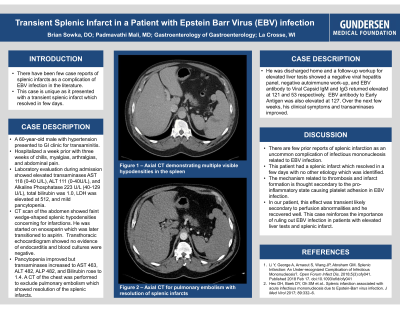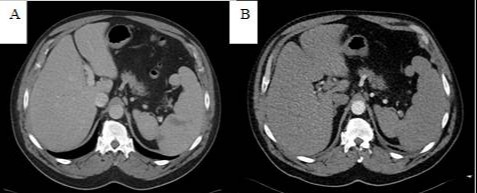Back


Poster Session A - Sunday Afternoon
Category: Liver
A0571 - Transient Splenic Infarct in a Patient With Epstein Barr Virus (EBV) Infection: A Rare Presentation
Sunday, October 23, 2022
5:00 PM – 7:00 PM ET
Location: Crown Ballroom

Has Audio

Brian Sowka, DO
Gundersen Health System
La Crosse, WI
Presenting Author(s)
Brian Sowka, DO, Padmavathi Mali, MD
Gundersen Health System, La Crosse, WI
Introduction: We report a case of transient splenic infarction as a rare complication of EBV infection. There have been few case reports of splenic infarcts as a complication of EBV infection in the literature. This case is unique as it presented with a transient splenic infarct which resolved in few days
Case Description/Methods: A 60-year-old male with a history of hypertension presented to the gastroenterology clinic in consultation for transaminitis. He presented to the hospital a week prior with three weeks of chills, myalgias, arthralgias, and abdominal pain. Laboratory evaluation during that admission showed elevated transaminases AST 118 (0-40 U/L), ALT 111 (0-40U/L), and Alkaline Phosphatase 223 U/L (40-129 U/L), total bilirubin was 1.0, LDH was elevated at 512, and mild pancytopenia. A CT scan of the abdomen showed faint wedge-shaped splenic hypodensities concerning for infarctions. He was started on enoxaparin which was later transitioned to aspirin. Transthoracic echocardiogram showed no evidence of endocarditis and blood cultures were negative. Pancytopenia improved but transaminases increased to AST 463, ALT 482, ALP 482, and Bilirubin rose to 1.4. A CT of the chest was performed to exclude pulmonary embolism which showed resolution of the splenic infarcts. He was discharged home and a follow-up workup for elevated liver tests showed a negative viral hepatitis panel, negative autoimmune work-up, and EBV antibody to Viral Capsid IgM and IgG returned elevated at 121 and 53 respectively. EBV antibody to Early Antigen was also elevated at 127. Over the next few weeks, his clinical symptoms and transaminases improved.
Discussion: There are few prior reports of splenic infarction as an uncommon complication of infectious mononucleosis related to EBV infection. This patient had a splenic infarct which resolved in a few days with no other etiology which was identified. The mechanism related to thrombosis and infarct formation is thought secondary to the pro-inflammatory state causing platelet adhesion in EBV infection. In our patient, this effect was transient likely secondary to perfusion abnormalities and he recovered well. This case reinforces the importance of ruling out EBV infection in patients with elevated liver tests and splenic infarct

Disclosures:
Brian Sowka, DO, Padmavathi Mali, MD. A0571 - Transient Splenic Infarct in a Patient With Epstein Barr Virus (EBV) Infection: A Rare Presentation, ACG 2022 Annual Scientific Meeting Abstracts. Charlotte, NC: American College of Gastroenterology.
Gundersen Health System, La Crosse, WI
Introduction: We report a case of transient splenic infarction as a rare complication of EBV infection. There have been few case reports of splenic infarcts as a complication of EBV infection in the literature. This case is unique as it presented with a transient splenic infarct which resolved in few days
Case Description/Methods: A 60-year-old male with a history of hypertension presented to the gastroenterology clinic in consultation for transaminitis. He presented to the hospital a week prior with three weeks of chills, myalgias, arthralgias, and abdominal pain. Laboratory evaluation during that admission showed elevated transaminases AST 118 (0-40 U/L), ALT 111 (0-40U/L), and Alkaline Phosphatase 223 U/L (40-129 U/L), total bilirubin was 1.0, LDH was elevated at 512, and mild pancytopenia. A CT scan of the abdomen showed faint wedge-shaped splenic hypodensities concerning for infarctions. He was started on enoxaparin which was later transitioned to aspirin. Transthoracic echocardiogram showed no evidence of endocarditis and blood cultures were negative. Pancytopenia improved but transaminases increased to AST 463, ALT 482, ALP 482, and Bilirubin rose to 1.4. A CT of the chest was performed to exclude pulmonary embolism which showed resolution of the splenic infarcts. He was discharged home and a follow-up workup for elevated liver tests showed a negative viral hepatitis panel, negative autoimmune work-up, and EBV antibody to Viral Capsid IgM and IgG returned elevated at 121 and 53 respectively. EBV antibody to Early Antigen was also elevated at 127. Over the next few weeks, his clinical symptoms and transaminases improved.
Discussion: There are few prior reports of splenic infarction as an uncommon complication of infectious mononucleosis related to EBV infection. This patient had a splenic infarct which resolved in a few days with no other etiology which was identified. The mechanism related to thrombosis and infarct formation is thought secondary to the pro-inflammatory state causing platelet adhesion in EBV infection. In our patient, this effect was transient likely secondary to perfusion abnormalities and he recovered well. This case reinforces the importance of ruling out EBV infection in patients with elevated liver tests and splenic infarct

Figure: A – Axial CT demonstrating multiple visible hypodensities in the spleen
B – Axial CT for pulmonary embolism with resolution of splenic infarcts
B – Axial CT for pulmonary embolism with resolution of splenic infarcts
Disclosures:
Brian Sowka indicated no relevant financial relationships.
Padmavathi Mali indicated no relevant financial relationships.
Brian Sowka, DO, Padmavathi Mali, MD. A0571 - Transient Splenic Infarct in a Patient With Epstein Barr Virus (EBV) Infection: A Rare Presentation, ACG 2022 Annual Scientific Meeting Abstracts. Charlotte, NC: American College of Gastroenterology.
